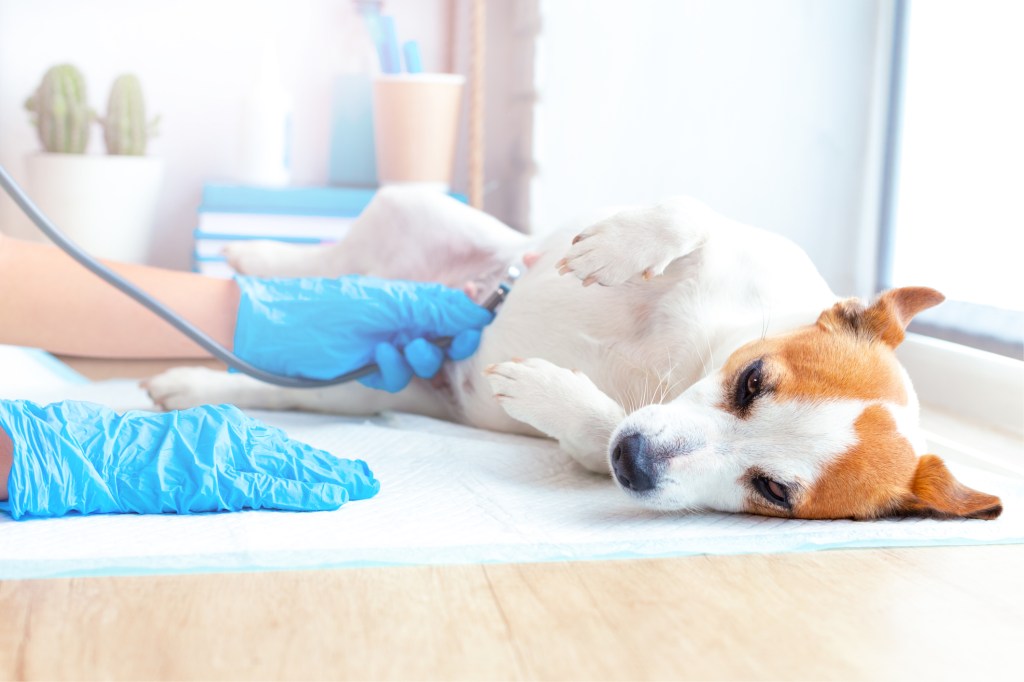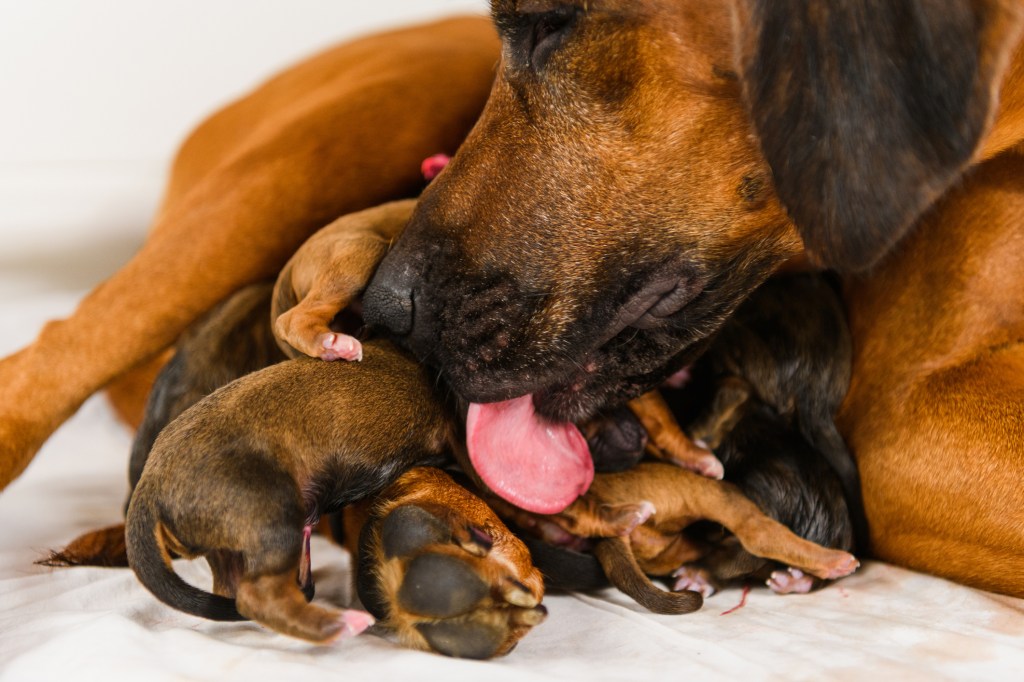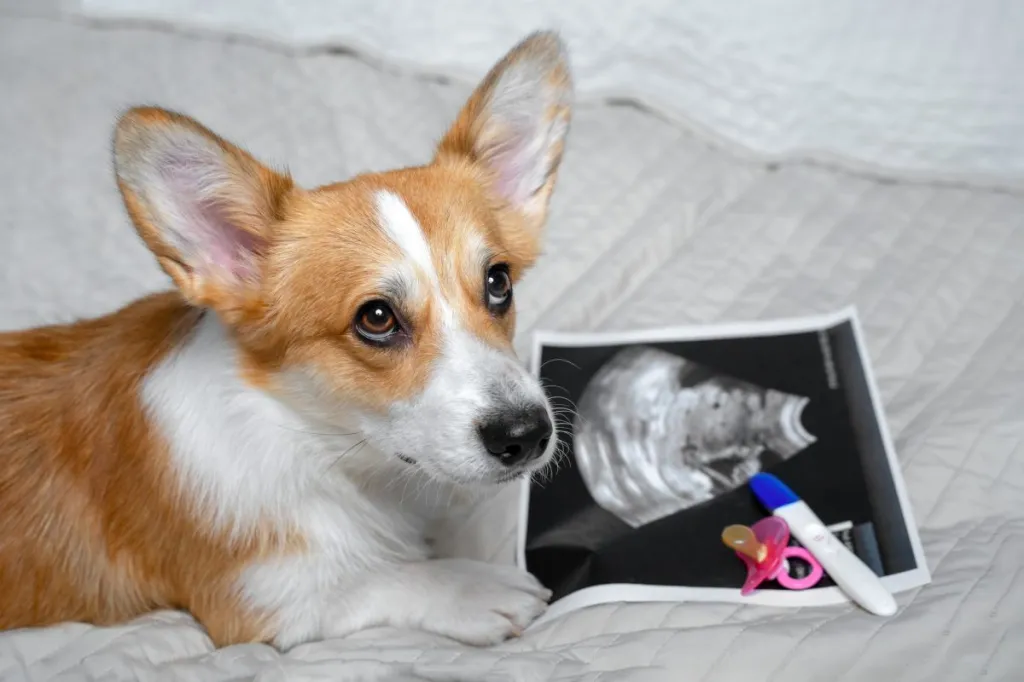Finding out your dog is pregnant can bring excitement and uncertainty. Regardless of how you feel about the big news, nature will take its course, and before you know it, you’ll help welcome a litter of puppies. So, exactly how long are dogs pregnant? What signs and symptoms of dog pregnancy should you look out for?
Symptoms and how to tell if your dog is pregnant

Noticeable pregnancy symptoms usually don’t appear until the third or fourth week. There will be very few outward signs in the earliest stages of a dog’s pregnancy, so you may not be sure of your suspicions for a while. You may notice some weight gain, but there are several reasons a dog might gain weight that aren’t related to pregnancy. As such, it is essential to consult a veterinarian if you suspect your dog is pregnant.
Decreased energy
Take note if your usually lively dog has suddenly traded in their playful antics for lazy lounging on the sofa. Of course, this may be more difficult to tell with less active dog breeds. Assuming you’ve ruled out any underlying health concerns, stay watchful for other telltale signs of dog pregnancy.
Enlarged abdomen and weight gain
One of the most evident signs of dog pregnancy is weight gain, which typically occurs later. In particular, pay close attention to weight in the belly area. If you still need to do so, now would be an excellent time to schedule a vet appointment.
Enlarged or swollen nipples
Typically, your dog’s nipples are relatively flat. However, during pregnancy, they may swell and become much more noticeable. The areolas also change, becoming more rounded. Additionally, the nipples darken in color. As the pregnancy progresses, swollen nipples may start to leak milk.
Appetite changes
Similar to humans, your dog may experience changes in appetite, especially early in pregnancy. They may also experience morning sickness, which is indicated by vomiting in the morning. To alleviate this, consider feeding your dog smaller meals throughout the day to prevent their stomachs from feeling overwhelmed.
Nesting behavior
If you have any doubts about your dog’s pregnancy, nesting is a late-stage sign of pregnancy. During the last few weeks of the gestation period, your dog might begin nesting behaviors. This could include dragging items to an area she feels is safe and secluded to build a nest or, as her wolf ancestors would, a den. She may also take to shredding items, like bedding or newspaper. Excessive grooming, done in anticipation of the arrival of her litter, is another nesting behavior you may notice.
How long are dogs pregnant?
Dogs are pregnant for about 63 days or nine weeks, though this may vary by a few days depending on several factors. A veterinarian can run tests to more accurately determine how far along the pregnancy is and when a dog will give birth.
As with humans, we separate the dog’s gestation period into three trimesters, each lasting about 21 days. While there are some outward signs of pregnancy in dogs, it’s hard to find out whether a dog is pregnant without veterinary tests, especially in the early stages, as many medical issues result in symptoms similar to those that appear during pregnancy.
How long until dogs show signs of pregnancy?
Noticeable pregnancy symptoms usually don’t appear until the third or fourth week. There will be very few outward signs in the earliest stages of a dog’s pregnancy, so you may not be sure of your suspicions for a while. You may notice some weight gain, but there are several reasons a dog might gain weight that aren’t related to pregnancy.
What is the dog pregnancy timeline?

During the first trimester, fetal development begins. Signs of pregnancy may not be evident. During the second trimester, outward signs of pregnancy may be more apparent. The final trimester involves rapid fetal growth and preparation for birth. Because symptoms of dog pregnancy can mimic signs of other medical conditions, it’s essential to have your vet run diagnostics if you suspect your dog is pregnant.
Your veterinarian will run some tests at several pregnancy stages and advise you on caring for and feeding your pregnant dog. A vet can feel the belly between the 25th and 28th day of pregnancy to determine if puppies are on the way. Only a professional vet should do this. If you try to feel for puppies on your own, you could harm the fetuses or cause a miscarriage. Your vet will be able to detect relaxin, the hormone produced by the placenta, as early as 22 to 27 days after breeding. This hormone is a good indicator of confirmed pregnancy.
Between days 28 and 35, your vet can run an ultrasound and detect the puppies’ heartbeats. They’ll be able to estimate how many puppies to expect in the litter, but they’ll be able to give a more accurate count once they can perform an x-ray later in the pregnancy.
Only at around 45 to 55 days can a vet perform an x-ray to see the puppies’ skeletons and accurately know the litter size. The closer this is done to the end of the pregnancy, the more accurate the count will be.
Dog gestation period
For a female dog to get pregnant, she must first be in heat. This happens about once every six months in dogs who haven’t had spay surgery. It’s important to note heat cycles vary depending on the size of the dog breed. Typically, the heat cycle lasts for 18 to 21 days. A female dog will be receptive to males starting about nine days into the cycle, and they may get pregnant any time over the next three to 11 days. Breeders keep track of these cycles and run tests to determine the optimum time for breeding.
When a dog becomes pregnant, the embryos travel through the uterine horn at around day seven. By day 16, the embryos embed in the uterine lining, and by day 22, the fetuses begin to form.
From day 28 to day 30, a vet will be able to see the heartbeats of the fetuses with an ultrasound. The puppies’ eyelids start to form around day 32. Toes form around day 35, claws come in around day 40, and the coat and skeleton come in around day 45.
After day 50, a veterinarian can perform an x-ray to see the puppies’ skeletons and form an accurate count of how many to expect in the litter. By around day 58, the puppies should be completely formed.
Later stages of dog pregnancy
Around day 40, the dog’s belly will start to expand. The nipples may get darker and begin to swell. It’s normal for some milky fluid to discharge from the nipples and shouldn’t cause concern. You can check with your vet if anything seems out of the ordinary.
During the final stages of pregnancy, the belly may sway when the mother dog walks. Around two weeks before she gives birth, you’ll probably be able to see and feel the puppies moving inside her belly.
For someone who’s not a professional or doesn’t have experience with pregnant dogs, the symptoms of pregnancy can be confused with other conditions, even at the later stages. To reiterate, your vet can run several tests to find out if your dog is pregnant, and you should rely on their professional medical advice.
Stages of dog labor

The pregnant dog will start looking for a place to nest and give birth once the puppies have fully formed. Labor should begin within the next three to four days.
In the 24 hours prior to giving birth, your dog’s body temperature may also temporarily drop a few degrees. Before delivering puppies, the pregnant dog’s body temperature will hover around 98 to 99 degrees Fahrenheit. Typically, dogs have an average temperature of 101 to 102.5 degrees.
Whelping is the term used to describe the process of a dog giving birth. Accordingly, you can buy whelping boxes in which your canine can safely and securely deliver her puppies. Labor happens in three stages, and a vet or someone with experience should supervise it, as complications can occur.
First stage
The first stage of labor lasts from about 12 to 24 hours. During this time, contractions begin in the uterus, but there may be no outward signs of contractions yet. The canine may seem restless, refuse to eat, vomit, paint, or show other signs that labor has begun.
Second stage
The mother dog gives birth to her puppies during the second stage of labor, which can take up to 24 hours. Usually, she gives birth to a puppy every 30 to 60 minutes, and each birth should take no more than two hours. Some dogs may experience delays in delivering additional puppies, thereby entering a resting period. This rest phrase should last no longer than four hours before she begins the next round of straining to deliver. It’s helpful to rely on a vet’s x-rays to know the number of expected puppies so it’s clear when stage two is complete.
Third stage
The third stage of labor happens when the placenta appears, and it will likely occur at around the same time as stage two. Stage three is complete when the last placentas have been delivered, and it should be finished shortly after stage two has ended. Dogs can go in and out of stage two and stage three, depending on the delivery and rest phases.
Of note, dogs will typically expel multiple placentas. It’s of paramount importance to count the number of placentas a dog passes to ensure it is equal to the number of puppies. Otherwise, it could be cause for concern and result in serious illness. Furthermore, do not be alarmed if your dog proceeds to eat the placenta. Many do. That said, you may also remove the placentas after she has passed them to keep an accurate count, as well as to prevent digestive issues and vomiting that can accompany the consumption of them.
Whelping

Once the dog has delivered or whelped a puppy, she should lick the offspring to remove them from their amniotic sac. She should also set to work chewing through the umbilical cord in order to detach it. Cleaning the newborn ensures it is viable, and you should hear the puppy begin to cry after this process. Bathing the dog is also a way to bond with her new puppy before they begin nursing.
If a mother dog does not show any interest in her new puppy or is unable to remove the amniotic sac, the puppy is in danger. At this point, you’ll need to carefully tear the sac’s membrane open to remove the puppy. After which, vigorously rub and dry the puppy with a clean towel until you hear tiny cries. You’ll also need to use string or thread to tie off the umbilical cord. Loop the thread approximately an inch from the belly wall before tying and proceeding to cut the cord on the other side. In a pinch, dental floss will also get the job done. Once finished, give the puppy back to their mother.
How to do a dog pregnancy test
If you suspect your dog is pregnant and you can’t get to a vet promptly, there are dog pregnancy tests you can purchase. These tests detect the hormone relaxin, produced by the placenta, which indicates pregnancy in dogs. You can search online for the best-reviewed dog pregnancy tests. However, it’s still crucial to visit your vet as soon as possible if your dog is pregnant. If you’re worried about the cost of vet care, look for affordable options in your area. The Humane Society offers resources to help you find budget-friendly veterinary care.
How to tell if it’s a false phantom pregnancy
False or phantom pregnancies can occur in unaltered female dogs. In a heat cycle, your dog’s body is preparing her for puppies. Hormones may cause similar symptoms to pregnancy, even if she isn’t pregnant. Signs of a false pregnancy include lethargy or depression, nesting behavior, appetite changes, mammary secretions, and behavioral changes. If you think these all sound like the signs mentioned above of pregnancy, you’d be right. Because the phantom pregnancy symptoms look very similar to those of an actual pregnancy, you’ll want to take your dog to the vet if you notice any of these. If your dog hasn’t been spayed, there’s a possibility she could be pregnant.
What to do and how to care for your pregnant dog

In the event your dog is pregnant, congratulations! In addition to ensuring she gets a checkup at the vet, prioritize nutrition. It’s imperative to make sure your mama-to-be is getting adequate nutrients she needs. A high-quality, high-calorie diet is essential. You’ll also want to ensure she has a safe place to nest. Keep other dogs and pets away from her as she approaches delivery. Monitor her temperature for any changes. You’ll know delivery is coming when her temperature drops below 100.
These tips serve as a starting point rather than an exhaustive guide. Conduct thorough research to ensure you’re equipped to care for your dog throughout her pregnancy, delivery, and after the birth of the puppies. It’s essential always to be prepared to provide care for both the mother and her puppies.
What food is good for a pregnant dog?
During the first two trimesters, it’s crucial to ensure your dog isn’t being overfed or underfed. While she should receive adequate nutrition, you don’t want to inadvertently cause obesity by overfeeding her in an attempt to ensure she eats enough. Generally speaking, her nutritional requirements are those of a young adult dog. As she enters the third trimester, the period of most rapid growth during pregnancy, it’s advisable to switch to easily digestible, nutrient-rich puppy food. Puppy formula food contains essential nutrients that support growth, which can also benefit the puppies’ development in utero.
Preventing dog pregnancy
If you have a female dog and you don’t wish for her to get pregnant, then you should have her spayed as soon as possible after she reaches sexual maturity. Your vet can help you figure out the right time for this procedure.
If you’re absolutely opposed to spaying, you’ll need to ensure your female dog doesn’t come into contact with unaltered male dogs. This includes having a secure yard, being watchful when other dogs are present, and staying vigilant for the remainder of your dog’s sexually mature life. You should especially take care of your dog during its heat cycles, as her scent will attract males, and she will be receptive during this time.
Preventing dog pregnancy is essential, as several hundred thousand shelter dogs are euthanized each year, and adding puppies to the pet population only increases that number. Even if you know you can find homes for your dog’s puppies, that still leaves several shelter dogs without the chance to find a loving home.









